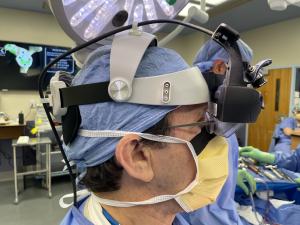UOI’s Dr. Andrew Green First Surgeon in New England to Use ARVIS® Augmented Reality System for Joint Replacement Surgery
Revolutionary AR Technology Enhances Precision, Reduces Cost for Shoulder Replacements
Developed by Enovis™, ARVIS® (Augmented Reality Visualization and Information System) is the only AR platform currently available in the United States that enables surgical navigation for shoulder joint replacements, all within a single, compact system, thus facilitating precise implant placement.
“I’ve incorporated ARVIS® into my practice because it’s designed specifically to fit the needs of my shoulder patients,” said Dr. Green, Chief of Shoulder and Elbow Surgery at Brown University Health and University Orthopedics. “After more than 30 years performing shoulder replacements, I know how important the small details are to a good result. My patients deserve the best tools and technology available. The ARVIS® system helps me to precisely position the implants, which is especially important in cases with more severe bone deformity. Published research studies show that computer-assisted planning and navigation improve the surgical accuracy over traditional unguided surgical techniques. With ARVIS®, I have complete control of the surgery.”
Shoulder pain caused by osteoarthritis and severe rotator cuff disorders is the most common reason for anatomic and reverse total shoulder replacements. While less common than hip and knee replacements, utilization of shoulder arthroplasty is increasing at a faster rate and is expected to rise as the population ages.
“Shoulder replacement requires time for recovery,” said Dr. Green, who is also a Professor of Orthopaedic Surgery at the Warren Alpert Medical School of Brown University. “Innovation and advances in technology, such as ARVIS®, will significantly impact how quickly patients return to the activities they love. ARVIS® allows for an individualized surgical experience tailored to each patient's unique anatomy.”
ARVIS® integrates tracking cameras, a 3D AR display, and a hands-free interface within a surgical helmet-compatible eyepiece. Its proprietary hardware enhances surgical precision while minimizing the physical footprint and financial burden associated with traditional robotic systems.
University Orthopedics’ adoption of ARVIS® marks a new era of accessible, high-tech orthopedic care for patients in New England and sets a precedent for other institutions nationwide.
For more information about Dr. Andrew Green and shoulder surgery at University Orthopedics, visit UOI.com or call 401-457-1500.
To learn more about ARVIS®, visit Enovis’ website.
Peter Lucas
Practice Marketing & Communications
+1 401-525-8113
email us here
Legal Disclaimer:
EIN Presswire provides this news content "as is" without warranty of any kind. We do not accept any responsibility or liability for the accuracy, content, images, videos, licenses, completeness, legality, or reliability of the information contained in this article. If you have any complaints or copyright issues related to this article, kindly contact the author above.
Car Accident Lawyer, Dean Weitzman of MyPhillyLawyer Featured in OK! Magazine for His Work on Mild Traumatic Brain Injury Awareness
Spanglish does it again: 'Patria Y Vida' Achieves Record-Breaking Success in U.S. Cinemas
From Beaches to Mountains: Vacation Ownership Club Model Built for Variety
Więcej ważnych informacji
 Jedynka Newserii
Jedynka Newserii

 Jedynka Newserii
Jedynka Newserii

Handel

Polskie MŚP otrzymają większe wsparcie w ekspansji międzynarodowej. To cel nowej inicjatywy sześciu instytucji
Firmy z sektora małych i średnich przedsiębiorstw otrzymają kompleksowe wsparcie na potrzeby zwiększania konkurencyjności na arenie międzynarodowej. Taki jest cel wspólnej inicjatywy instytucji zrzeszonych w Grupie PFR pod szyldem Team Poland. Obejmuje ona zarówno wsparcie kapitałowe, w postaci gwarancji, pożyczek czy ubezpieczenia, jak i doradztwo oraz wsparcie promocyjne i informacyjne, dzięki czemu mikro-, małym i średnim firmom łatwiej będzie podjąć decyzję o ekspansji zagranicznej. Pierwszy projekt dotyczy wsparcia dla firm zainteresowanych uczestnictwem w odbudowie Ukrainy.
Bankowość
RPP zgodna co do potrzeby obniżania stóp procentowych. Trwają dyskusje dotyczące tempa tych decyzji

W lipcu Rada Polityki Pieniężnej po raz drugi w tym roku obniżyła stopy procentowe, określając swój ruch mianem dostosowania. W kolejnych miesiącach można oczekiwać kolejnych obniżek, ale ich tempo i termin będą zależeć od efektów dotychczasowych decyzji i wzrostu płac. Docelowo główna stopa procentowa ma wynosić 3,5 proc. Te okoliczności sprzyjają kredytobiorcom.
Handel
Umowa z krajami Mercosur coraz bliżej. W. Buda: Polska nie wykorzystała swojej prezydencji do jej zablokowania

– Polska podczas prezydencji w Radzie UE nie wykorzystała szansy na obronę swoich interesów w sprawie umowy z krajami Mercosur – ocenia europoseł PiS Waldemar Buda. W jego ocenie polski rząd, mimo sprzeciwu wobec zapisów umowy, nie zbudował w UE sojuszy niezbędnych do jej odrzucenia. Porozumienie o wolnym handlu spotyka się przede wszystkim z protestami europejskich rolników, którzy obawiają się zalania wspólnego rynku tańszą żywnością z krajów Ameryki Południowej. Według europosła wszystko może się rozegrać w najbliższych tygodniach.
Partner serwisu
Szkolenia

Akademia Newserii
Akademia Newserii to projekt, w ramach którego najlepsi polscy dziennikarze biznesowi, giełdowi oraz lifestylowi, a także szkoleniowcy z wieloletnim doświadczeniem dzielą się swoją wiedzą nt. pracy z mediami.





![Część środków z Planu Społeczno-Klimatycznego trafi na walkę z ubóstwem transportowym. Organizacje branżowe apelują o zmianę priorytetowych projektów [DEPESZA]](https://www.newseria.pl/files/1097841585/rower3,w_85,_small.jpg)




.gif)

 |
| |
| |
|